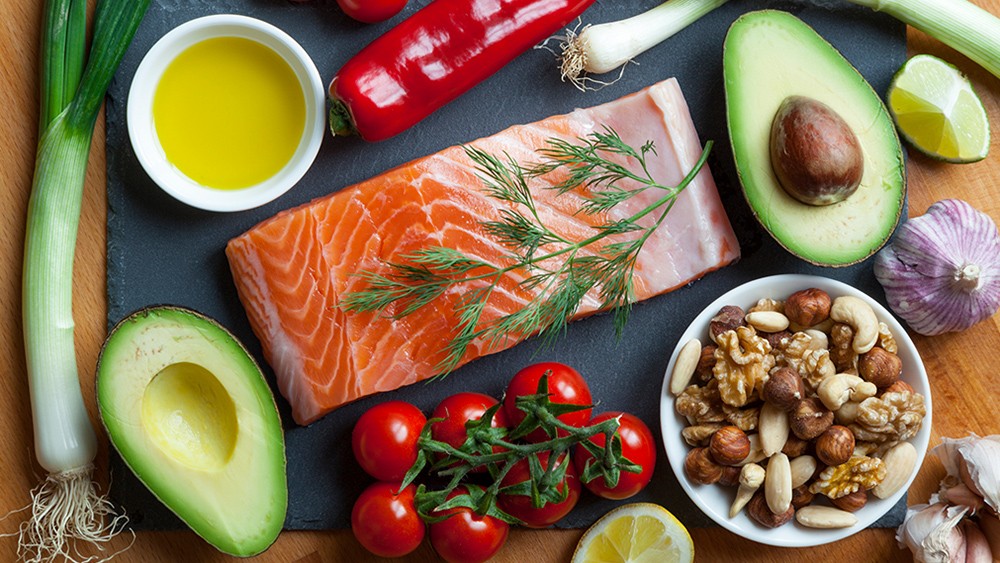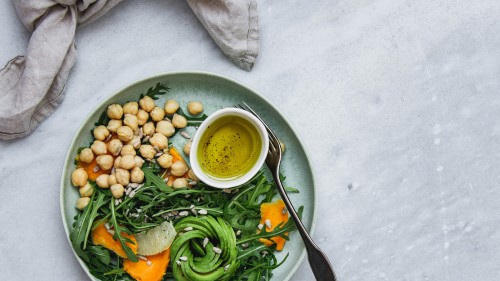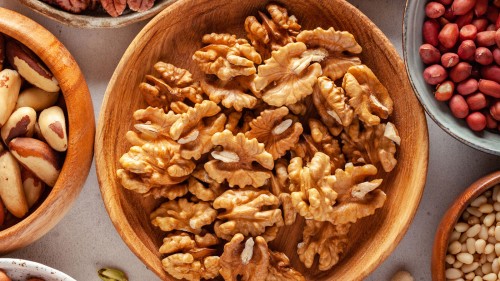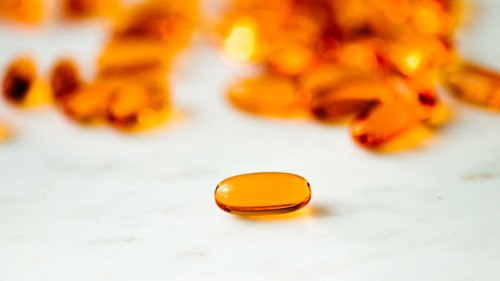10 Foods That Can Help Lower High Cholesterol
Published on December 7, 2021
Medically Reviewed by Anthony Dugarte, MD
If you have been diagnosed with high cholesterol, you might be looking for foods to help lower it. What are some foods you can add to your diet that lower cholesterol levels?


Heart disease remains the number one killer of men and women worldwide. (1)
There are several known risk factors for heart disease, including high blood fats like cholesterol.
While cholesterol-lowering medications are often prescribed, the truth is, there are also other important lifestyle habits that can help support healthy cholesterol levels, like your nutrition.
If you’re struggling with high cholesterol, consider adding some of these foods into your regular diet as part of your action plan.
What Is Cholesterol?
Cholesterol is a thick, waxy substance that travels through your blood.
There are two main types of cholesterol. (2)
High-density lipoprotein (HDL) “good” cholesterol helps clean cholesterol from your body by transporting it from your arteries to your liver.
Low-density lipoprotein (LDL) “bad” cholesterol can accumulate in your arteries and cause blockages that lead to stroke and heart attacks.
There’s a common misconception that cholesterol is only found in foods, but the truth is that cholesterol is also made by your liver for use by the rest of your body.
This is because your body needs cholesterol to make vitamins, hormones, and substances to digest food and build cells and nerves.
Cholesterol is only found in animal products in the diet, including meat, fish, poultry, eggs, and dairy.
Plant foods do not contain cholesterol.
Do you need cholesterol in your diet? Nope. Your liver makes all of the cholesterol your body requires for the purposes mentioned.
There’s controversy around whether eating cholesterol deserves as much blame as it has received when it comes to heart health.
However, research suggests that the primary reason eating a lot of cholesterol-containing foods can cause higher cholesterol levels over time is likely that these foods are also high in trans and saturated fat.
It’s this combination that may promote more cholesterol production by your liver than usual. In other words, saturated and trans fat may deserve more attention when it comes to heart health.
For example, a 2017 study published in Nutrients discussed how replacing saturated fats with carbohydrates has no benefit for heart disease risk, whereas replacing saturated fats with unsaturated fats appears to improve heart health. (3)
The Dietary Guidelines for Americans 2015–2020 recommends limiting saturated fat intake to less than 10% of total caloric intake.
As for trans fats, while man-made ones have been banned from the food system, they are still naturally occurring in animal products.
And because of their known ability to raise blood fats like LDL and triglycerides, the Institute of Medicine says there’s no safe level of trans fat consumption. (3)
What Does High Cholesterol Mean?
While cholesterol often gets a negative reputation attached to it, it’s not inherently bad. However, this can be problematic when the amount of cholesterol circulating within your blood becomes higher than recommended.
Ideally, you want to have a high ratio of HDL to LDL to help keep your total cholesterol levels in a healthy range.
When you have high LDL and low HDL levels, combined with high levels of another blood fat called triglycerides, this significantly increases your risk for heart disease. (4, 5)
The only way to know that you have high cholesterol is to have a blood test, called a “lipid panel,” done by your physician.
A fasting cholesterol test, generally done in the morning following a night of not eating, is the most accurate way to collect these numbers. A fasting test is necessary because a single meal can alter your cholesterol levels, and you don’t want inaccurate readings.
A blood cholesterol test will tell you the following markers: total cholesterol, LDL, HDL, and triglycerides. Healthy parameters for these are listed in the table below for the average adult. (6)
| Biomarker | Optimal Range |
| Total Cholesterol | Less than 200 mg/dL |
| LDL | Less than 100 mg/dL |
| HDL | 60 mg/dL or higher |
| Triglycerides | Less than 150 mg/dL |
How to Lower Cholesterol
It’s important to be clear that no single food is a cure-all for any health condition, including lowering high cholesterol or blood fats.
Furthermore, even a healthy diet that includes many of the following foods may not be enough to help lower high cholesterol for some people.
If you find that even implementing the recommended lifestyle changes for high cholesterol, including a healthy diet and regular exercise, it’s a good idea to speak with your healthcare provider to determine the best next steps for you.
For many people, this involves the use of certain cholesterol-lowering medications.
Still, creating a diet pattern that contains plenty of foods that support healthy cholesterol levels is a great place to start.
These foods aren’t just ideal for supporting normal cholesterol and blood fat levels; they also have a lot to offer your health in general.
Overall, when looking for foods to lower cholesterol, a good approach is to limit your intake of foods high in saturated fat and cholesterol.
Instead, replace these with sources of unsaturated fat and fiber.
Eating more fiber has been shown to be inversely associated with heart disease risk, but unfortunately, fiber intake is low in western cultures. (7)
Ten Cholesterol-Lowering Foods
Looking for foods to help support healthy cholesterol levels? Consider adding some of these to your diet.
1. Walnuts
Walnuts are high in omega-3 fats, which are unsaturated and good for your heart. (8)
They also contain compounds called phytosterols, which are known to reduce LDL without negatively impacting HDL. (9)
A 2013 study published in the Journal of Nutrition found that consuming walnuts was effective for increasing cholesterol efflux, or the ability of HDL to transport cholesterol from the arteries and to the liver for disposal. (10)
Overall, eating a variety of nuts has been shown to have a cholesterol-lowering effect and have positive benefits for other heart disease risk factors like blood pressure, oxidative stress, and inflammation. (11)
Put It Into Action
- Walnuts make a great snack on their own or as part of a trail mix, alongside dark chocolate pieces and dried fruit.
- They can also be crushed and sprinkled over oatmeal, mixed into a muffin and pancake batters, or added to yogurt bowls.
2. Avocado
Avocados are full of monounsaturated fats, and one average fruit contains nearly 13 grams of fiber. (12)
In one 2015 study published in the Journal of the American Heart Association, researchers found that 45 overweight or obese participants with high LDL at baseline could significantly lower their LDL by eating one avocado per day for five weeks. (13)
Their results were more substantial than those fed a low-fat diet (24–34% fat) or a moderate-fat diet that used high oleic acid oils to match the fat content of one avocado.
Additionally, a 2016 meta-analysis of ten studies on avocado-enriched diets found that replacing other dietary fat sources with avocados was linked to having lower total cholesterol, LDL, and triglyceride levels. (14)
Put It Into Action
- Make avocado toast for breakfast simply by mashing ripe avocado on toasted bread and topping with things like sliced tomatoes and onions, sprouts, pepitas, hemp seeds, and balsamic vinegar.
- You can also make guacamole or add sliced avocado to salads and tacos, or use them as a topper for burgers and sandwiches.
3. Fatty Fish
Fish with higher fat content, such as tuna, mackerel, and salmon, are rich in omega-3 fatty acids to benefit heart health.
In a large 25-year follow-up study published in 2016, researchers prospectively followed 4,356 healthy young American adults, looking for the development of the metabolic syndrome and its components related to fatty fish intake. (15)
At the end of the study, 1,069 incident cases of metabolic syndrome were identified.
The authors concluded that long-chain omega-3 intake from non-fried fatty fish was inversely associated with metabolic syndrome in a dose-response manner.
And in a 2005 comparative study among 4,775 older adults, researchers found that participants who consumed baked or broiled fish, like tuna, 1–4 times per week, had a 27% lower risk of having a stroke, compared to those who ate this fewer than one time per month. (16)
Keep in mind that the most heart health benefit from fatty fish is experienced when you consume them roasted, steamed, broiled, or baked, rather than fried, which may promote the opposite effect. (17)
Put It Into Action
Enjoy some of these fish by roasting them in the oven and adding them to salads, or serving them alongside things like mashed potatoes and greens for a well-rounded meal.
4. Beans and Lentils
Beans and lentils, also called pulses or legumes, are full of protein, fiber, and an array of vitamins and minerals.
Their texture, flavor, and versatility in cooking make them excellent cholesterol and saturated fat-free substitutes for ground beef and other meats.
A 2011 meta-analysis of 10 randomized clinical trials conducted between January 1980 to July 2009 found that diets rich in non-soy legumes effectively reduce total and LDL cholesterol compared to diets that are not. (18)
Furthermore, a 2014 review of 26 randomized controlled trials, including over 1,000 participants, found that people who consumed at least one serving (130 grams) of dietary pulses daily for a minimum of 3 weeks significantly lowered LDL compared to control groups. (19)
Put It Into Action
- Cooked or canned beans and lentils are a perfect base for tacos, chilis, and stews. They can be added to soups or mixed into cold green salads.
- Use lentils to make plant-based sloppy joes, dahl, or to add more protein to spaghetti sauce.
- Chickpeas, in particular, make a great substitute for canned chicken in recipes like chickpea salad sandwiches.
5. Garlic and Onions
Garlic and onions, known as allium vegetables, contain an active compound called allicin, which is responsible for many of their health benefits, including for the heart. (20)
A 2012 animal study found that allicin given to hypercholesterolemic mice daily for 12 weeks effectively reduced cholesterol and triglycerides. (21)
It also significantly reduced how much cholesterol was stored in their liver compared to the control group.
Other research has found that allium vegetables like garlic may benefit other heart disease risk factors, like blood pressure, in addition to potentially helping lower cholesterol. (22, 23)
Put It Into Action
- Minced garlic and diced onions are a flavorful and nutrient-dense base for countless stovetop recipes, such as soups, stews, and chilis, as well as homemade veggie burger patties, enchiladas, and casseroles.
- Onions are also a great addition to salads, burgers, and sandwiches.
6. Soy
Soy is a legume, and soy foods like tofu, tempeh, and edamame (soybeans) may also help support normal cholesterol levels.
For instance, a 2015 meta-analysis of 35 studies concluded that consuming soy foods may help lower total and LDL cholesterol, while also helping to increase HDL. (24)
The effects are most prominent among people who have high cholesterol levels at baseline.
Additionally, the most benefit is seen when you consume whole soy foods, like those mentioned above, rather than soy in supplemental form (like protein powders, etc.).
For example, the analysis above found that isoflavone supplementation had no effects on lipid profile.
Put It Into Action
- Try crumbled extra-firm tofu in place of eggs for a savory breakfast scramble, along with a variety of chopped veggies and seasonings.
- Cubed tofu can be roasted and added to bowls or incorporated uncooked into soups and on salads.
- Tempeh can be thinly sliced and used in stir-fries or crumbled to add bulk to chilis and plant-based sloppy joes.
- You can even enjoy edamame as a snack (often sold in pod form in the frozen vegetable section).
7. Dark Leafy Greens
Not only are dark leafy greens high in fiber, but they’re also rich in pigment carotenoids like lutein.
Carotenoids may be especially good for the heart because of their ability to remove harmful free radicals that can promote hardened arteries. (25)
A 2016 review published in the American Journal of Clinical Nutrition concluded that diets high in lutein, which promote a higher blood concentration of lutein, are associated with overall better cardiovascular health, though more research is needed. (26)
An older 2011 animal study suggested that lutein could offer antioxidant and anti-inflammatory benefits and help lower LDL and prevent cholesterol from binding to arteries in guinea pigs. (27)
Additionally, dark leafy greens may bind to bile acids in your body when you eat them, helping to promote the removal of cholesterol. (28)
Put It Into Action
- Try a mixture of chopped greens in your next salad, like spinach, romaine, butter lettuce, kale, and arugula.
- Swiss chard, mustard greens, and collard greens are delicious sauteed with a bit of oil and garlic on the stovetop.
- Raw greens are great in tacos, sandwiches, wraps, or used as a base for serving pasta dishes.
- Spinach and kale are also easy to add to smoothies. If the flavor is too “green,” just add a more acidic fruit like pineapple and green apple.
Related: Healthiest Leafy Greens and How to Use Them More Often
8. Extra Virgin Olive Oil
No oil can necessarily be considered a health food, but a small amount here and there may offer heart health benefits without going overboard with fat and calories.
Extra virgin olive oil (EVOO) is a staple food on a Mediterranean diet, which has been shown to support heart health. (29)
In a 2013 study among 7,447 adults at risk for heart disease, published in the New England Journal of Medicine, researchers divided the participants into three diet groups: a Mediterranean diet plus 4 tablespoons daily of EVOO, a Mediterranean diet plus mixed nuts, or a control diet with the advice to limit dietary fat intake. (30)
After a median follow-up of 4.8 years, they found that the EVOO group had a 30% lower risk of major heart events than the low-fat diet group.
Put It Into Action
- EVOO works well for softening fresh chopped veggies on the stove, making stir-fries, or drizzling over potatoes before roasting them in the oven.
- It also pairs well with flavorful vinegar for salad dressings.
9. Oats
Oats are whole grain, a category of foods that have been observed to reduce heart disease risk factors.
For example, a 2016 review of 45 studies concluded that eating at least three servings of whole grains per day could reduce heart disease and stroke risk by up to 20%. (31)
Oats contain a type of soluble fiber called beta-glucan, which has been specifically studied for its ability to help lower high cholesterol levels.
In a 2011 review, the researchers found that oat consumption is associated with 5% and 7% reductions in total and LDL cholesterol, respectively. This is thanks primarily to its beta-glucan content. (32)
Put It Into Action
- The most obvious way to eat oats is cooked for breakfast, or you could prepare them in a jar overnight with milk, fruit, and other flavoring agents to make overnight oats for the next day.
- Oats can also be added to smoothies, incorporated into muffins and cookies, or pulverized into a homemade oat flour for baking.
Dig Deeper: Top Health Benefits of Oats and Oatmeal
10. Berries
Colorful berries are full of anthocyanins, a type of antioxidant that gives them their beautiful pigments. They’re also rich in soluble fiber, which helps support normal cholesterol levels. (33, 34)
One type of fiber in berries and other fruits is called pectin.
According to one 2012 randomized controlled trial, consuming around 15 grams of pectin per day for four weeks could reduce mildly high cholesterol levels by 10%. (35)
Another 2008 study found that eating a moderate amount of berries daily for eight weeks significantly increased HDL levels among participants compared to the control group. (36)
Put It Into Action
- Berries are best served fresh and eaten by a handful.
- Whether you like blueberries, raspberries, blackberries, or strawberries best, you can eat these raw or add them to smoothies, slice them on top of cereal and oatmeal, mix them into yogurt bowls, or add some into your pancake and waffles mixes for breakfast.
The Bottom Line
Are there cholesterol-lowering foods?
No single food is magic when it comes to heart health, but a diet based on foods that are low or free from saturated fat and cholesterol and instead high in fiber, unsaturated fats, and antioxidants can really help.
Incorporating plenty of whole plant foods, like avocados, legumes, nuts, berries, and greens, as well as enjoying fatty fish, are great features for low cholesterol meals and may even help lower LDL cholesterol.
A healthy overall diet with lots of fruits and vegetables, unsaturated fats, and antioxidants is the key to lowering cholesterol levels.
Always start by speaking to your doctor about what is best for you.
At WellnessVerge, we only use reputable sources, including peer-reviewed medical journals and well-respected academic institutions.
- World Health Organization: The top 10 causes of death:
https://www.who.int/en/news-room/fact-sheets/detail/the-top-10-causes-of-death - What is Cholesterol?:
https://www.heart.org/en/health-topics/cholesterol/about-cholesterol - A healthy approach to dietary fats: understanding the science and taking action to reduce consumer confusion:
https://www.ncbi.nlm.nih.gov/pmc/articles/PMC5577766/ - European Guidelines on cardiovascular disease prevention in clinical practice (version 2012). The Fifth Joint Task Force of the European Society of Cardiology and Other Societies on Cardiovascular Disease Prevention in Clinical Practice (constituted by representatives of nine societies and by invited experts):
https://pubmed.ncbi.nlm.nih.gov/22555213/ - Comparison of serum lipid values in patients with coronary artery disease at <50, 50 to 59, 60 to 69, and >70 years of age:
https://pubmed.ncbi.nlm.nih.gov/16360350/ - 2018 AHA/ACC/AACVPR/AAPA/ABC/ACPM/ADA/AGS/APhA/ASPC/NLA/PCNA Guideline on the Management of Blood Cholesterol: A Report of the American College of Cardiology/American Heart Association Task Force on Clinical Practice Guidelines:
https://www.ahajournals.org/doi/10.1161/CIR.0000000000000625 - Dietary Fiber, Atherosclerosis, and Cardiovascular Disease:
https://pubmed.ncbi.nlm.nih.gov/31126110/ - Nuts: Health Effects:
https://www.sciencedirect.com/science/article/pii/B9780123849472004967 - A review on the role of phytosterols: new insights into cardiovascular risk:
https://pubmed.ncbi.nlm.nih.gov/22188455/ - Acute Consumption of Walnuts and Walnut Components Differentially Affect Postprandial Lipemia, Endothelial Function, Oxidative Stress, and Cholesterol Efflux in Humans with Mild Hypercholesterolemia1,2,3,4:
https://www.ncbi.nlm.nih.gov/pmc/articles/PMC3652880/ - Health Benefits of Nut Consumption:
https://www.ncbi.nlm.nih.gov/pmc/articles/PMC3257681/ - Agricultural Research Service, FoodData Service: Avocados, raw, all commercial varieties:
https://fdc.nal.usda.gov/fdc-app.html#/food-details/171705/nutrients - Effect of a Moderate Fat Diet With and Without Avocados on Lipoprotein Particle Number, Size and Subclasses in Overweight and Obese Adults: A Randomized, Controlled Trial:
https://www.ncbi.nlm.nih.gov/pmc/articles/PMC4330060/ - Impact of avocado-enriched diets on plasma lipoproteins: A meta-analysis:
https://www.sciencedirect.com/science/article/pii/S1933287415004274 - Intake of fish and long-chain omega-3 polyunsaturated fatty acids and incidence of metabolic syndrome among American young adults: a 25-year follow-up study:
https://pubmed.ncbi.nlm.nih.gov/26816031/ - Fish consumption and stroke risk in elderly individuals: the cardiovascular health study:
https://pubmed.ncbi.nlm.nih.gov/15668367/ - Dietary fried fish intake increases risk of CVD: the REasons for Geographic And Racial Differences in Stroke (REGARDS) study:
https://pubmed.ncbi.nlm.nih.gov/27338865/ - Non-soy legume consumption lowers cholesterol levels: a meta-analysis of randomized controlled trials:
https://pubmed.ncbi.nlm.nih.gov/19939654/ - Effect of dietary pulse intake on established therapeutic lipid targets for cardiovascular risk reduction: a systematic review and meta-analysis of randomized controlled trials:
https://pubmed.ncbi.nlm.nih.gov/24710915/ - An umbrella review of garlic intake and risk of cardiovascular disease:
https://www.sciencedirect.com/science/article/abs/pii/S0944711315003359 - Cholesterol-lowering effect of allicin on hypercholesterolemic ICR mice:
https://pubmed.ncbi.nlm.nih.gov/22928080/ - Effect of garlic on blood pressure: a meta-analysis:
https://pubmed.ncbi.nlm.nih.gov/25557383/ - Garlic Lowers Blood Pressure in Hypertensive Individuals, Regulates Serum Cholesterol, and Stimulates Immunity: An Updated Meta-analysis and Review:
https://pubmed.ncbi.nlm.nih.gov/26764326/ - Soya products and serum lipids: a meta-analysis of randomised controlled trials:
https://pubmed.ncbi.nlm.nih.gov/26268987/ - Carotenoids and cardiovascular risk:
https://pubmed.ncbi.nlm.nih.gov/22747421/ - The effects of lutein on cardiometabolic health across the life course: a systematic review and meta-analysis:
https://pubmed.ncbi.nlm.nih.gov/26762372/ - A lutein-enriched diet prevents cholesterol accumulation and decreases oxidized LDL and inflammatory cytokines in the aorta of guinea pigs:
https://pubmed.ncbi.nlm.nih.gov/21697302/ - Steam cooking significantly improves in vitro bile acid binding of collard greens, kale, mustard greens, broccoli, green bell pepper, and cabbage:
https://pubmed.ncbi.nlm.nih.gov/19083431/ - Olive oil and cardiovascular health:
https://pubmed.ncbi.nlm.nih.gov/19858733/ - Primary Prevention of Cardiovascular Disease with a Mediterranean Diet:
https://www.nejm.org/doi/full/10.1056/NEJMoa1200303 - Whole grain consumption and risk of cardiovascular disease, cancer, and all cause and cause specific mortality: systematic review and dose-response meta-analysis of prospective studies:
https://pubmed.ncbi.nlm.nih.gov/27301975/ - Cholesterol-lowering effects of oat β-glucan:
https://pubmed.ncbi.nlm.nih.gov/21631511/ - Berries and Related Fruits:
https://www.sciencedirect.com/science/article/pii/B978012384947200060X - Effects of soluble dietary fiber on low-density lipoprotein cholesterol and coronary heart disease risk:
https://pubmed.ncbi.nlm.nih.gov/18937894/ - Cholesterol-lowering properties of different pectin types in mildly hyper-cholesterolemic men and women:
https://pubmed.ncbi.nlm.nih.gov/22190137/ - Favorable effects of berry consumption on platelet function, blood pressure, and HDL cholesterol:
https://pubmed.ncbi.nlm.nih.gov/18258621/






